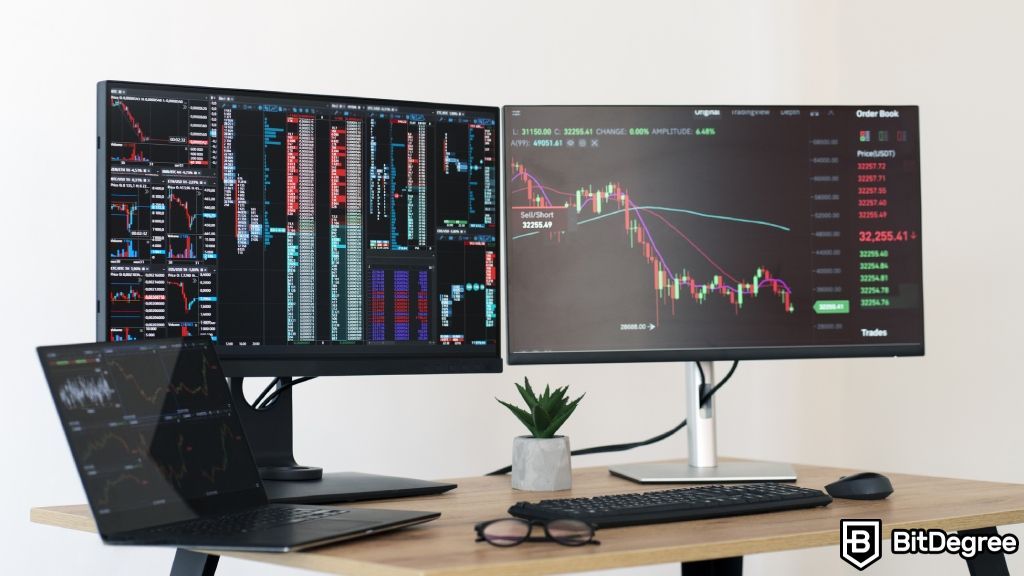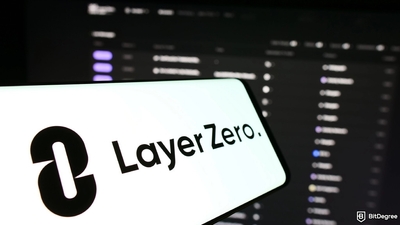Key Takeaways
- The fully diluted valuation measures the value of a project by considering all tokens that can ever be created and the current token price;
- FDV, meaning crypto price prediction metric, should be combined with other metrics for more accurate price predictions;
- Fully diluted pre-money valuation, on the other hand, considers the valuation of a cryptocurrency project before any additional tokens are created or distributed.
Free Airdrop Season 7 is LIVE! Answer fun questions or do simple tasks to earn rewards from the $30K BitDegree prize pool. Participate Now ! 🔥
When analyzing tokens and projects, you might stumble upon the term fully diluted valuation (or FDV, for short). But what is the FDV meaning in crypto?
While it does sound pretty complicated, it's actually not. In essence, it's a prediction of an asset's future price.
That said, let's explore the fully diluted valuation meaning and its importance for crypto traders together. This way, the next time you're trading on Binance, Kraken, or KuCoin, you'll be equipped to incorporate this metric and make more informed decisions.

Did you know?
Subscribe - We publish new crypto explainer videos every week!
Is Cryptocurrency a Good Investment? (5 PROS & CONS!)


Table of Contents
- 1. Understanding the FDV Meaning in Crypto
- 1.1. Market Cap VS Fully Diluted Market Cap
- 2. How to Calculate FDV?
- 3. The Importance of FDV in Investment Decisions
- 4. Challenges and Limitations
- 5. Real-World Examples
- 5.1. The Case of Stellar (XLM)
- 5.2. Locked Tokens in Chainlink (LINK)
- 5.3. The Polkadot (DOT) Treasury
- 6. Is Fully Diluted Valuation a Useful Metric?
- 7. Conclusions
Understanding the FDV Meaning in Crypto
So, what is the FDV meaning crypto traders refer to when discussing a crypto project?
Latest Deal Active Right Now:Head to BitDegree Missions, gather as many Bits as possible & claim your stake of the $30,000 Prize Pool! Don't waste your time & start collecting Bits by completing Missions and referring friends.
Imagine you're at a pizza party. You and your friends are eyeing the delicious sliced delights served at the center table. Let's say that the pizzas in this party represent a cryptocurrency project. Each slice of pizza signifies a token, so the slices you're seeing are the tokens in circulation.
As time goes on, the party host starts to bring in more slices (tokens). He also tells you how many slices he bought for the party in total, and that he plans to keep bringing them to the table over time. Additionally, he tells you how much each slice costs.
So, what would the FDV meaning be in this context?
Well, it would measure the total worth of all the slices that will ever be available in this party combined, including those extra slices that will be added in the future and the ones already on everyone's plates and bellies.

Therefore, the FDV meaning in crypto gives you a sneak peek into the potential future value of a project if all the tokens, even the ones that aren't out yet, were in circulation and kept their current market price[1].
So, this includes not only the currently circulating supply but also any tokens reserved for the project team, advisors, initial investors, or allocated for future release through mechanisms like mining, staking rewards, or token vesting schedules.
Now, you might wonder why FDV, meaning crypto future price prediction, matters to your trading adventures.
Well, here's the deal: FDV gives you a broader perspective on a project's potential value. While the current market cap tells you about the project's existing worth, FDV adds that extra layer of insight by considering tokens that are supposed to come into play down the line.
By factoring in potential future tokens, FDV helps you anticipate how market dynamics might change when new tokens hit the scene. This can impact the value of the tokens you're holding or eyeing, influencing your trading decisions.

As you navigate the crypto trading landscape on platforms like Kraken, KuCoin, and Binance, understanding FDV meaning in crypto can be like having an extra slice of knowledge at your pizza party – it might not fill your belly, but it'll certainly satisfy your craving for better-informed decisions.
Besides, in case you're wondering what fully diluted pre-money valuation is, it's also a prediction of the potential price, but it's a bit different than FDV.
In essence, the fully diluted pre-money valuation is the theoretical valuation of the project based on its current token distribution and market capitalization, excluding any future tokens that may be created or distributed through mechanisms like token sales, airdrops, or token generation events.
Either way, both fully diluted pre-money valuation and fully diluted valuation help investors and analysts understand the potential impact of token supply on the overall valuation of a cryptocurrency project.
Market Cap VS Fully Diluted Market Cap
While researching your favorite crypto project, you might notice two values: market cap and fully diluted market cap. The latter is just another way of saying fully diluted valuation. To convey the FDV meaning crypto traders talk about, others might also refer to it as fully diluted value (they all mean the same).
Let's start with the market cap, though.
In crypto, the market cap is determined by multiplying the current price of a single coin or token by the total number of coins or tokens in circulation. It's a snapshot of the market's perception of the cryptocurrency's value based on its current price and the number of units available.
For instance, if there are 1 million ShinyCoin tokens circulating, each priced at $10, the market cap would be $10 million (1 million tokens x $10 per token).

Fully diluted market cap, on the other hand, goes beyond this. Think of FDV as the expanded version of the market cap – it takes into account not only the coins or tokens currently in circulation but all that have already been created and those that could potentially enter the market in the future.
To calculate FDV, you consider the maximum supply of coins or tokens that could exist. This includes those that are yet to be created, are already circulating, were burned, or are locked in the project's reserves. It provides a broader view of the potential value of a cryptocurrency if all the coins were to become available.
In a nutshell, the market cap gives you a snapshot of the current value of a cryptocurrency project based on its existing coins or tokens that are circulating (both in the market and in public hands). On the other hand, FDV takes into account not just the current supply, but also potential future additions to the supply.

Both market cap and fully diluted valuation have their merits. Market cap reflects the present reality, while FDV provides a more comprehensive outlook for the potential future.
Crypto enthusiasts and traders often use these metrics to assess investment potential, but it's essential to remember that they're just tools in the crypto toolkit – each offering a different angle on a coin's worth.
So, whether you're crunching numbers to make investment decisions or simply satisfying your curiosity, understanding the difference between market cap and fully diluted market cap will undoubtedly put you in a better position to navigate the crypto landscape.
How to Calculate FDV?
Calculating the FDV, meaning crypto project's potential value, is simple, as you might've already grasped with the explanations given in the previous chapter. Still, I'm gonna provide you with a short step-by-step guide on how to calculate the fully diluted valuation crypto projects may fail to add to their tokenomics information.
Step 1. Gather the numbers. Before diving into the math, you'll need some basic figures, such as:
- Current Token Price. There is not much to explain here; you just need to find the current price of the asset in question. You can find the current prices of over 21,000 tokens on the BitDegree crypto tracker.
- Maximum Supply (MS). The max supply represents the upper limit of tokens that a cryptocurrency protocol or project can ever create. It is usually a predetermined value that defines the absolute ceiling on the number of tokens that will ever be in circulation. This includes total supply, unissued tokens, and burned tokens.
However, if the maximum supply is not available or it is limitless, the total supply is used instead.
Step 2. Calculate the FDV. The formula for the FDV is:
FDV = MS x Current Token Price
Here's how you plug in the numbers:
Let's say a crypto project has a total supply (TS) of 600,000 tokens, 400,000 unissued tokens (UT), and no burned tokens. This means the project's maximum supply – which is TS + UT + burned tokens – is 1,000,000 tokens. The current token price is $100.
So, what is fully diluted valuation of this crypto project?
FDV = (600,000 + 400,000 + 0) x $100
FDV = 1,000,000 x $100
FDV = $100,000,000
Pretty easy to calculate, right? Though, you don't have to calculate it yourself. You can find the FDV (and other metrics) of many crypto projects on the aforementioned crypto tracker.
![]()
But hey, did you notice how I said max supply "is usually a predetermined value"? That's because there are actually three types of max supply:
- Fixed max supply is the model adopted by most cryptocurrencies. In it, a predetermined maximum quantity of coins is set, maintaining a steadfast count that remains impervious to shifts in demand. Bitcoin serves as a prime illustration of this arrangement, and this is the model we used in our FDV calculations.
- Deflationary max supply signifies a deliberate reduction in the upper limit of available coins as time progresses. Cryptocurrencies often employ this strategy to curtail inflation rates and amplify their inherent scarcity. Ethereum wishes to eventually adopt a deflationary max supply framework.
- Dynamic max supply introduces a malleable facet into the equation, adjusting in response to predetermined factors like supply, demand, and inflation. This adaptable approach is meticulously designed to harmonize with market dynamics, offering heightened flexibility in fluctuating conditions.
When analyzing cryptocurrencies that adopt a deflationary or dynamic model, the FDV meaning crypto changes, so FDV is calculated as:
Total Supply (TS) x Current Token Price
In other words, projects that adopt models where the max supply can change have their FDV calculated as if all of their tokens were already in circulation, which will result in a value that is usually close to market cap (but not always, as market cap considers only circulating supply, not total supply).
The Importance of FDV in Investment Decisions
So, what is the FDV meaning in crypto informing you about, and why is it important to your investment decisions?
As you already know, FDV takes into account all the tokens a project has ever created and the potential new tokens that could still be created. As such, it provides a comprehensive view of a crypto project's potential value, considering both what's already out there and what might come into existence.
Now, let's say you're evaluating two crypto projects.
Project A has a market capitalization of $10 million, while Project B boasts a market cap of $100 million. At first glance, you might think Project B is the more valuable one. However, if Project A has only issued a small portion of its total tokens, while Project B has nearly all its tokens in circulation, your perception might be skewed.
This is where FDV steps in as one of the metrics to take into consideration.
It prevents misleading comparisons by providing a fuller picture of a project's potential worth. While Project B might have a higher market cap, its fully diluted valuation in the crypto market might be significantly lower than Project A's due to a larger number of existing tokens.

Besides that, investors often seek to gauge a crypto project's growth potential. FDV acts as sort of a crystal ball by considering all possible tokens that could be in existence down the line.
Remember, you're not just looking at the current situation; you're also factoring in future developments, like token vesting schedules, additional token sales, or even potential network upgrades.
By incorporating the FDV perspective into your investment analysis, you're better equipped to anticipate how a project might evolve and whether it aligns with your long-term goals.
Fully diluted valuation might sound like a mouthful, but it's a vital concept for any crypto trader or investor to grasp. It ensures you're not just scratching the surface when evaluating a project's potential. By understanding FDV, you're gaining insights that could steer you toward more informed investment decisions.
So, next time you're eyeing a promising crypto venture, don't forget to factor in its FDV.
However, it's important to note the FDV meaning in crypto projects is a tad limited, so fully diluted values should never be analyzed on their own.
Challenges and Limitations
Now that you've explored the FDV meaning crypto traders refer to and its significance in the world of cryptocurrencies, let's take a closer look at some of the challenges and limitations that come along with using FDV.
Simplistic Calculations
For starters, while FDV offers a view of a crypto project's potential value, it involves simple calculations that might not capture the whole picture.
Crypto projects often have various types of tokens, like utility tokens, governance tokens, and more. Each of these tokens might have different vesting schedules, conversion rates, and rights. The fully diluted valuation meaning is not really able to take all that into account.
Reliance on Assumptions
Secondly, calculating FDV relies on making certain assumptions about the future, such as the total supply of tokens that will be in circulation. However, these assumptions might not always pan out as expected.

Factors like changes in token distribution, regulatory shifts, or unexpected events in the crypto market can influence the accuracy of the FDV calculation. It's important to remember that FDV is based on projections, and these projections might not always align with reality.
Volatility Impact
Furthermore, crypto markets are infamous for their high levels of volatility. Prices can swing dramatically in a short period, which can significantly impact the value of tokens and the overall FDV. Sudden market crashes or rapid price spikes can throw off even the most well-calculated FDV estimations.
Besides, as a token's circulating supply increases, the crypto market might perceive it as less scarce and, therefore, less valuable – especially if the new tokens come in too quickly. In other words, traders and investors should be prepared for the inherent unpredictability of the crypto market.
Rapidly Changing Landscape
Lastly, the crypto landscape evolves at a rapid pace. New technologies, competitors, regulations, and market trends can swiftly alter the conditions that FDV calculations are based on. What might seem like a solid FDV today could quickly become outdated tomorrow.
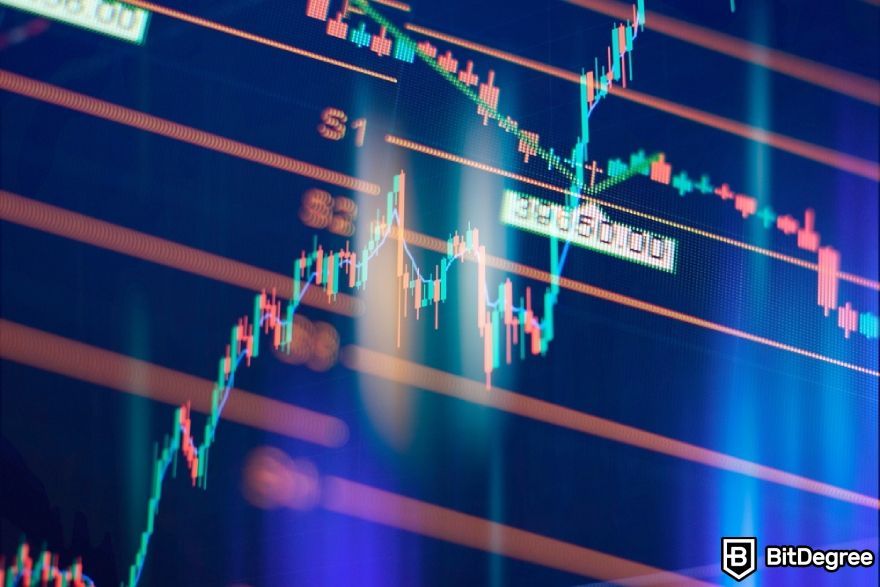
Because of that, staying updated with the latest information and adjusting your calculations accordingly is crucial to make informed decisions.
In conclusion, while fully diluted valuation is a decent tool for traders and investors, it's essential to be aware that it's just one of the many metrics to consider.
The primitive calculation, unrealized factors, market volatility, and changing circumstances all play a role in shaping the accuracy and reliability of FDV. When using FDV as part of your investment strategy, it's wise to complement it with other metrics and a good dose of critical thinking.
Real-World Examples
Since you already know the FDV meaning crypto enthusiasts keep talking about, it's time to explore some real-world examples that showcase how FDV plays a crucial role in assessing the potential value of crypto projects.
The Case of Stellar (XLM)
Stellar, often dubbed as a blockchain for payments, provides a prime example of how understanding FDV meaning in crypto can help investors make informed decisions.
Imagine you're considering investing in Stellar's native token, XLM. The project has a total supply of 50,001,787,030 XLM tokens, but only around 57% are currently in circulation.
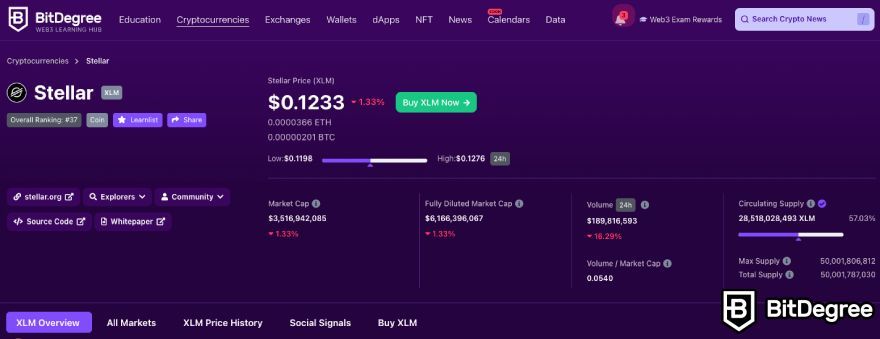
Now, let's say the current market price of XLM is $0.1233. If you were only looking at the market cap, which is based on the circulating supply, you might end up concluding the project's value is around $3.5 billion.
However, considering the FDV, the project's potential value is actually around $6.1 billion, which is almost close to double the current value. This broader perspective helps you gauge the project's future prospects.
Locked Tokens in Chainlink (LINK)
Chainlink, renowned for its decentralized oracle network, provides an intriguing example involving locked tokens.
Suppose you're interested in Chainlink's native token, LINK, which has a maximum supply and a total supply of 1 billion tokens. Since MS and TS are the same, this means that all LINK tokens that could ever be created already exist.
To simplify calculations, let's consider that 587 million tokens are circulating, priced at around $20 each.
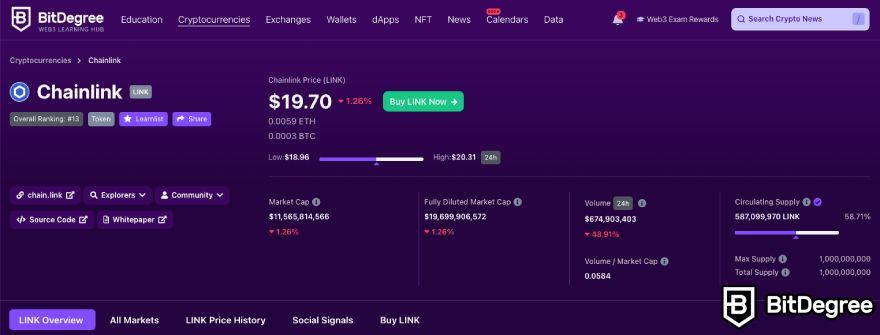
A unique aspect of Chainlink is that a substantial portion of its tokens is locked up, either by the team, long-term holders, or for ecosystem development.
Considering FDV, the total token supply is accounted for, including the locked tokens. Thus, while Chainlink's market cap is around $11,6 billion, its FDV would be at $20 billion.
This expanded perspective underlines the influence of locked tokens on a project's valuation.

- Secure and reliable
- Accepts fiat currencies
- Lots of trading options
- Reputable exchange
- Accepts fiat currencies
- Offers various trading options

- Fiat currencies - accepted
- Simple to use
- Accepts only the most trustworthy cryptocurrencies
- A leading cryptocurrency exchange platform
- Best for beginner investors
- Accepts fiat currencies

- Beginner-friendly
- Secure
- Decent trading and withdrawal fees
The Polkadot (DOT) Treasury
Polkadot, a pioneering multi-chain blockchain platform, presents an interesting scenario involving token reserves. For this example, it's important to note that Polkadot doesn't have a max supply.
Now, imagine you're investigating Polkadot's native token, DOT. The circulating supply currently stands at around 1.29 billion DOT tokens, valued at approximately $8.40 each.
However, Polkadot's ecosystem has a treasury with around 45 million DOT tokens held for development and future initiatives[2]. This token reserve, although not yet in circulation, is still part of the overall FDV consideration.

While the calculated market cap using circulating supply is around $10.7 billion, the FDV perspective acknowledges the potential valuation of approximately $11.8 billion, encapsulating the entirety of token distribution.
With these real-world examples, you can see how understanding fully diluted valuation crypto goes beyond just looking at current market conditions. It involves considering the entire token supply, even if all tokens are not in circulation.
By grasping FDV meaning, crypto traders can better assess the potential growth and value of a project, making more informed investment decisions.
Is Fully Diluted Valuation a Useful Metric?
Considering the FDV meaning in crypto you've already fully grasped, it's time to talk about whether it is a useful metric or not.
At its core, fully diluted valuation aims to give us a comprehensive view of a cryptocurrency project's potential value, taking into account all the tokens that could possibly be in circulation.
This includes not only the currently circulating tokens but also those that could be created in the future through mechanisms like mining, staking rewards, or token sales. In a way, FDV can offer a 'what if' scenario.
Now, you might be wondering: Why should I care about a hypothetical scenario?
Well, that's a valid question.

FDV can provide insights into a project's scalability and potential future dilution.
Imagine a scenario where a cryptocurrency has a high FDV due to a massive number of tokens yet to be released. This might suggest that the current value is spread thin and could potentially lead to price dilution over time, affecting your investment.
On the other hand, a lower FDV could indicate that the project has already released a significant portion of its tokens, potentially signaling a more stabilized value. It's like looking at a pizza – if the pizza is already sliced into many pieces, it's less likely to be sliced into even smaller ones later.
However, before you start making decisions solely based on FDV, it's essential to consider the bigger picture. FDV doesn't account for factors like the project's technology, adoption, competition, or overall market trends. A high FDV doesn't necessarily mean a project *will* succeed, and a low FDV doesn't mean it's doomed.

Think of FDV as just one piece of the puzzle, rather than the entire puzzle itself. Combining FDV with other fundamental and technical analysis tools can provide a more well-rounded understanding of a cryptocurrency's potential.
To sum up, the fully diluted valuation can indeed be a useful metric, but it's not the be-all and end-all of crypto investing. It can help you gauge a project's token distribution and potential dilution risks, but it's important to consider other critical factors that can influence a cryptocurrency's success.
Conclusions
So, what is fully diluted valuation? After reading this article, I hope the FDV meaning crypto traders talk about is completely clear to you. After all, understanding key concepts like this can truly set you up for success.
Put briefly, FDV is a vital metric that goes beyond just the market price of a coin. It takes into account all potential tokens that could be in circulation, giving you a clearer picture of a crypto project's overall potential value.
By grasping the FDV meaning in crypto, you're equipped with a powerful tool to help you make informed investment decisions. So, the next time you're looking for crypto investment opportunities on KuCoin, Kraken, or Binance, you'll have an extra metric to take into consideration.
The content published on this website is not aimed to give any kind of financial, investment, trading, or any other form of advice. BitDegree.org does not endorse or suggest you to buy, sell or hold any kind of cryptocurrency. Before making financial investment decisions, do consult your financial advisor.
Scientific References
1. E. Soure, S. Lyu, X. Wen, et al.: 'Kirin: An Interactive Visualization for Decentralized Finance Applications in Ethereum Blockchain';
2. J. Burdges, A. Cevallos, P. Czaban, et al.: 'Overview of Polkadot and its Design Considerations'.

